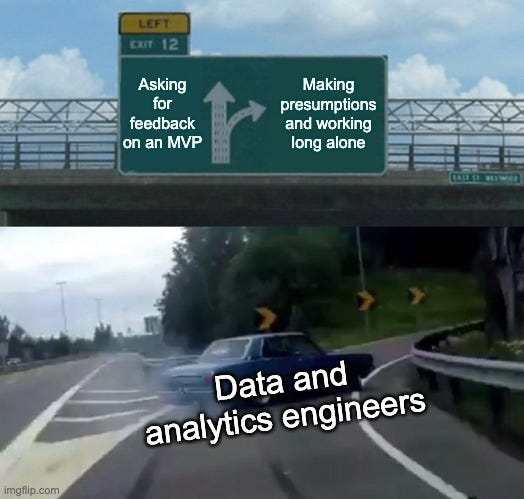Stop Building Bold Data Products: Do This Instead
How to use the power of Minimum Viable Products for your next data project
This article is part of the Plan and scope like a data product manager playlist. Click here to explore the full series.
You don’t need to look too far to find all kinds of failed data products. The chances are your BI tool looks like a dashboard graveyard. As a DataOps practitioner, you value your work and want to ensure it’s worth something to your stakeholders.
Proper project management processes can increase the success ratio of your data products. Minimum Viable Products help you decrease the complexity of your project management process, improve stakeholder engagement, and increase the chance for success.
In this issue of Data Gibberish you will learn:
How broad scope increases your chance for failure
Why you must embrace the Minimum Viable Product approach
How to build an MVP data product the right way
Read time: 6 minutes
But before that, my picks of the week.
Picks Of The Week
Do you want to up your stakeholder management game? Ella Pham has your back! The latest issue of Data & Beyond helps you forge a perfect fit between data and business. (link)
Earlier this week, Daniel Beach from Data Engineering Central posted a rather controversial post comparing DuckDB and Polars. I’m keen to learn which one you prefer and if you agree with Dan’s statement. (link)
Proper time management is crucial for you as an effective DataOps professional. Notion launched a Calendar app recently, and I love it! (link)
Now, on the main topic.
Why Thinking Too Big Is Wrong
Picture this: The company you work for just acquired another smaller business. Your manager comes to you with a request to build a unified customer dashboard reflecting the new multi-product nature of the organisation.
More often than not, you’d dive deep into the project. You’d use all your time to gather requirements and work behind the scenes. You’d share it and collect feedback when confident in your work.
Unfortunately, although it makes sense, working on a project behind the scenes is wrong.
According to research by Spectacles, the chances are over 70% of the dashboards in your organisation are just useless. These dashboards might have had some use, but they fail to engage the audience in the long run.
And if that’s not enough, another piece VentureBeat highlights that 87% of data science projects never make it into production. People behind the research explain that gigantic scope leads to extended development time.
Here are a handful more points about why spending too much time before delivering is harmful to your data product:
Market fit: Let’s face it, sometimes our initiatives are born from a wild guess. But you must defend the time and money you spend, especially if nobody needs your product. Does your target audience need your solution?
Changing priorities: A priority today may not be one tomorrow. You may have spent weeks building the pipeline and dashboard when an Excel spreadsheet could do the trick. Do you always need to do things “the right way”?
Wrong direction: Stakeholders sometimes struggle to explain what their needs are. Like a lost boat floating to nowhere, you may be working on a project far from your stakeholders’ needs. You work with presumptions. Can you save time if you ask for feedback earlier?
Now for the other part of the story. Let’s talk about the DataOps approach.
Do The Minimum
Stop spending weeks or even months alone in the dark room. Instead, turn every project into a data product. Involve your stakeholders in the process. Make them care about the product. Make sure your work is worth it.
Successful startup projects around the world achieve this by building Minimum Viable Products or MVPs. This is a mighty concept, which means shipping a version of your (data) product with just a few vital features. You hook customers and make the product sticky by iterating on valuable features.
If MVPs work for startups with no customers, there’s no reason why they wouldn’t work for you and your stakeholders.
Here is how you can build a Minimum Viable Product in 4 simple steps:
Simplify requirements: Collect a list of ideas and ask what is the absolute minimum. Put everything else in the backlog.
Ship quickly: Do not spend too much on your task. It’s okay to build your report in Excel with sample data.
Engage early: Contact your stakeholders immediately. Request feedback. Ask how you can improve.
Start over: Once the result is good enough, you can pick another requirement and start the next iteration on your data product.
The benefits of this approach are countless. Let me list just a few:
Minimising risk: You spend minimum effort, time and money, so it’s not a huge problem if your stakeholder suddenly decides they don’t need that dashboard anymore.
Learning opportunity: You never know what you don’t know. Short feedback loops allow you to discover things you couldn’t predict.
Ownership: When you involve your customers in development they get attached to the final product. They are interested in making it superb and using it for longer.
As you can see, iterating on a Minimum Viable Product is fundamental for a successful data product. Now, let’s wrap it up.
Summary
In the world of data projects, thinking too big can lead to wasted efforts and boring dashboards. In this issue of Data Gibberish, I shared with you how Minimum Viable Products save your data products from oblivion.
Simplify requirements, ship quickly, engage stakeholders early, and iterate for continuous improvement. This strategy minimises risk, unlocks learning opportunities, and fosters stakeholder ownership.
Ready to Revolutionise Your Approach?
Implement MVP, engage early, and watch your data products soar!
Did you enjoy that piece? Follow me on LinkedIn for daily updates.






